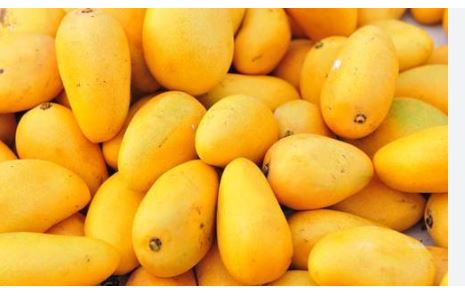
Ataulfo mangoes, often called Honey or Champagne mangoes, belong to the species Mangifera indica, within the Anacardiaceae family, sharing lineage with cashews and pistachios. This tropical evergreen species, native to South Asia, has been selectively bred into numerous cultivars, with Ataulfo emerging as a standout for its petite size and creamy texture. Its botanical roots tie it to the vast mango family, known for fleshy stone fruits.
The Ataulfo mango hails from Chiapas, Mexico, where it was developed in the 1940s by Ataulfo Morales Gordillo, a grower who discovered this unique strain on his land. Likely a natural hybrid of Manila mangoes introduced by Spanish traders centuries earlier, it was refined through grafting and selective cultivation. By the 1950s, it gained local acclaim, and its commercial rise took off in the 1990s as exports to the U.S. and Canada surged. Today, Mexico dominates its production, with the Ataulfo earning a Denomination of Origin status in 2003, cementing its cultural and agricultural significance.
Ataulfo mangoes are small, typically 6–12 ounces, with an oblong, slightly flattened shape and a thin, edible skin that ripens from green to a deep golden-yellow. The flesh is a brilliant yellow-orange, silky-smooth, and virtually fiber-free, surrounding a thin, flat pit that maximizes edible yield. Their taste is exceptionally sweet—honey-like, as the nickname suggests—with a buttery richness and faint citrus undertones. Lacking tartness, they offer a concentrated, tropical decadence that’s less assertive than larger varieties but deeply satisfying.
Ataulfo mangoes deliver a compact nutritional package. A single fruit (about 150 grams) provides roughly 90–100 calories, with high vitamin C for immune support and skin health, and vitamin A for eyesight. They offer 2–3 grams of fiber for digestion, plus potassium and magnesium for muscle and nerve function. Antioxidants like polyphenols and beta-carotene combat inflammation, while enzymes aid digestion. Their smaller size makes portion control easy, though the skin’s urushiol can irritate some, a quirk of their Anacardiaceae kin.
Ataulfo mango trees flourish in USDA Hardiness Zones 10–11, requiring frost-free, tropical conditions with temperatures above 40°F (4°C) and ideally 70–95°F (21–35°C). They need full sun and a climate mirroring Mexico’s—dry winters for flowering, humid summers for fruiting. In the U.S., they’re grown in South Florida, Southern California, and Hawaii, though they’re less hardy than some cultivars. Cold-sensitive, they’re often cultivated in greenhouses or as potted plants outside these zones.
Culinary Applications of Ataulfo (Honey Mango)
- Fresh Eating: Peeled or scored, their buttery flesh is a melt-in-your-mouth snack, perfect solo or with a lime squeeze.
- Smoothies: Blended with berries or almond milk, they lend a velvety texture and honeyed sweetness without overpowering.
- Salsas: Finely chopped with serrano peppers and red onion, they add a lush, sweet contrast to spicy tacos or grilled fish.
- Desserts: Pureed into mousse or sliced atop panna cotta, their rich flavor elevates sweets with minimal effort.
- Salads: Diced into quinoa or kale mixes, they bring a juicy, golden pop alongside nuts or feta.
- Sorbet: Churned with a touch of lemon, their smooth consistency makes a refreshing, naturally sweet frozen treat.
- Dressings: Blended into vinaigrettes with vinegar and oil, they infuse salads with a tropical, fruity depth.
- Ceviche: Mixed with shrimp or white fish, their sweetness balances lime and chili for a bright, summery dish.
Cultivation of Ataulfo (Honey Mango)
- Climate: Ataulfo mangoes thrive in tropical climates, favoring temperatures of 70–95°F (21–35°C), with a dry season (2–3 months) to spur flowering and humid conditions to support fruit set.
- Soil: They prefer well-drained, sandy loam or loamy soils with a pH of 5.5–7.5, enriched with organic matter; waterlogging can stunt their shallow root systems.
- Propagation: Grafting onto resilient rootstocks like ‘Manila’ or ‘Criollo’ is the norm, ensuring true-to-type fruit and hastening production (within 3–4 years) compared to seed-grown trees.
- Planting: Trees are spaced 15–20 feet (4.5–6 meters) apart due to their smaller stature, planted at the rainy season’s start in holes mixed with compost for robust early growth.
- Irrigation: Young trees need consistent watering (1–2 times weekly) for 2–3 years; mature trees rely on seasonal rains, with light irrigation during dry spells to sustain yields.
- Pruning: Minimal pruning after harvest maintains an open canopy, removes dead branches, and keeps trees at 8–12 feet (2.4–3.6 meters) for easy picking and air circulation.
- Fertilization: A balanced fertilizer (e.g., 10-10-10) is applied 2–3 times yearly, with extra potassium and micronutrients like zinc to boost fruit quality and size.
- Flowering: Induced by a dry period or cool nights (50–60°F or 10–15°C), flowering occurs in late winter to early spring, aided by bees and natural wind pollination.
- Fruiting: Fruits ripen in 90–110 days, peaking from March to June in Mexico; a mature tree (6–10 years) can produce 100–200 small mangoes annually, often consistently.
- Pest Management: Susceptible to fruit flies, anthracnose, and scale, they’re treated with organic sprays (neem oil) or targeted fungicides, especially during wet bloom phases.
- Harvesting: Fruits are picked mature but firm (yellow-green), hand-harvested with care to avoid bruising, then ripened off-tree for optimal sweetness and texture.
- Yield Optimization: Their smaller size and disease resistance make them reliable, though growers may thin fruit clusters to enhance size and quality, avoiding overproduction stress.